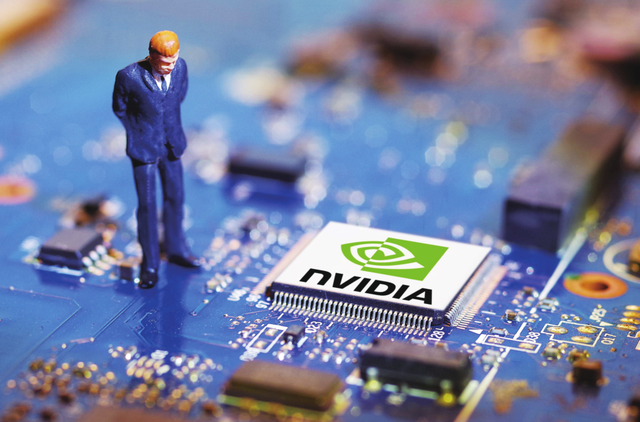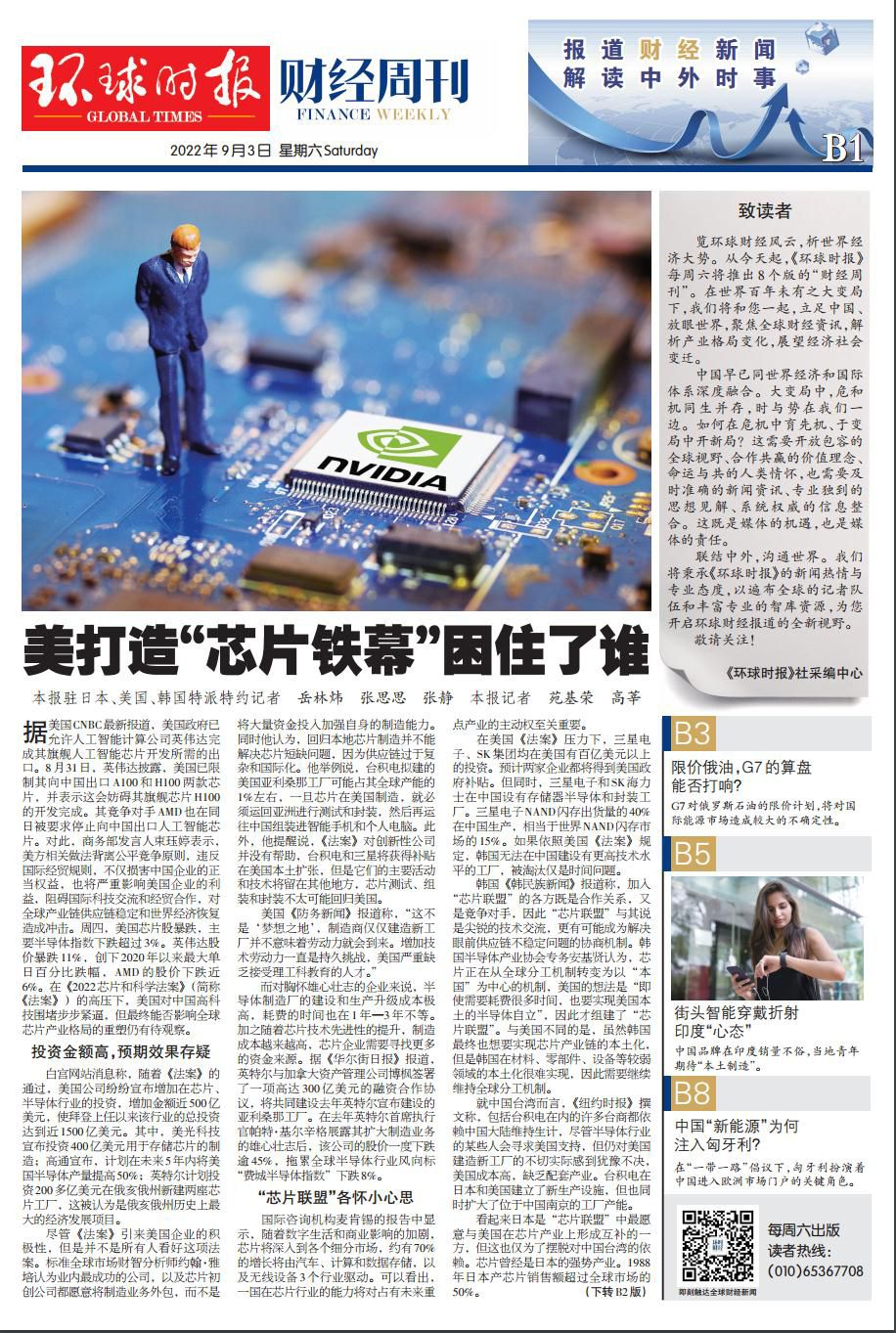With high investment amounts and questionable expected outcomes, who is trapped by the ‘Chip Iron Curtain’ created by the United States?
According to a recent report by CNBC, the U.S. government has allowed artificial intelligence computing company NVIDIA to complete the export necessary for the development of its flagship AI chip. On August 31, NVIDIA disclosed that the U.S. has restricted its exports of the A100 and H100 chips to China, stating that this would hinder the completion of its flagship H100 chip development. Its competitor AMD was also required to stop exporting AI chips to China on the same day. In response, Ministry of Commerce spokesperson Shu Jueting stated that the U.S. actions deviate from the principles of fair competition and violate international trade rules, harming the legitimate rights and interests of Chinese companies while severely impacting U.S. companies’ interests, obstructing international technological exchanges and economic cooperation, and causing shocks to the stability of global industrial and supply chains and the recovery of the world economy. Last Thursday, U.S. chip stocks plummeted, with the major semiconductor index falling over 3%. NVIDIA’s stock price dropped by 11%, marking the largest single-day percentage decline since 2020, while AMD’s stock price fell nearly 6%. Under the pressure of the CHIPS and Science Act of 2022, the U.S. is tightening its blockade against China’s high-tech sector, but whether it can ultimately influence the reshaping of the global chip industry landscape remains to be seen.
High Investment Amounts, Questionable Expected Outcomes
According to a message from the White House, following the passage of the Act, U.S. companies have announced an increase in investments in the chip and semiconductor industry, totaling nearly $50 billion, bringing the total investment in this sector since Biden took office to nearly $150 billion. Micron Technology announced a $40 billion investment for the manufacturing of memory chips; Qualcomm announced plans to increase U.S. semiconductor production by 50% over the next five years; Intel plans to invest over $20 billion to build two chip factories in Ohio, considered the largest economic development project in Ohio’s history.
Despite the enthusiasm from U.S. companies regarding the Act, not everyone is optimistic about it. John Abbott, an analyst at Standard Global Market Intelligence, believes that the most successful companies in the industry, as well as chip startups, prefer to outsource manufacturing rather than invest heavily in strengthening their own manufacturing capabilities. He also believes that returning to local chip manufacturing will not solve the chip shortage problem due to the overly complex and internationalized supply chain. He cited the example of TSMC’s planned factory in Arizona, which may account for only about 1% of its global capacity; once chips are manufactured in the U.S., they must be sent back to Asia for testing and packaging before being shipped to China for assembly into smartphones and personal computers. Furthermore, he warned that the Act does not help innovative companies; TSMC and Samsung will receive subsidies to expand in the U.S., but their main activities and technologies will remain elsewhere, and chip testing, assembly, and packaging are unlikely to return to the U.S.
 Reference Image
Reference Image
According to U.S. Defense News, “This is not a ‘dreamland’; merely building new factories does not mean that the workforce will come. Increasing the technical workforce has always been a persistent challenge, and the U.S. is severely lacking in talent with STEM education.”
For ambitious companies, the costs of building semiconductor manufacturing plants and upgrading production are extremely high, taking between 1 to 3 years. Additionally, as chip technology advances, manufacturing costs are rising, and chip companies need to seek more funding sources. According to the Wall Street Journal, Intel has signed a financing cooperation agreement worth up to $30 billion with Canadian asset management company Brookfield to jointly build the Arizona factory announced by Intel last year. After Intel CEO Pat Gelsinger revealed his ambition to expand manufacturing, the company’s stock price once fell over 45%, dragging down the global semiconductor industry benchmark, the Philadelphia Semiconductor Index, by 8%.
The ‘Chip Alliance’ Has Its Own Concerns
A report from international consulting firm McKinsey shows that as digital life and business impacts intensify, chips will penetrate various sub-markets, with about 70% of growth driven by the automotive, computing, and data storage, as well as wireless device industries. It is evident that a country’s capabilities in the chip industry will be crucial for holding the initiative in future key industries.
Under the pressure of the U.S. Act, both Samsung Electronics and SK Group have made investments of over $10 billion in the U.S. It is expected that both companies will receive subsidies from the U.S. government. However, at the same time, Samsung Electronics and SK Hynix have memory semiconductor and packaging factories in China. Samsung Electronics produces 40% of its NAND flash shipments in China, which accounts for 15% of the global NAND flash market. If the U.S. Act’s regulations are followed, South Korea will not be able to build higher technology-level factories in China, and elimination is only a matter of time.
According to the Korean newspaper Hankyoreh, the parties involved in the ‘Chip Alliance’ are both collaborators and competitors, so the ‘Chip Alliance’ is more likely to become a negotiation mechanism to solve the current supply chain instability issues rather than a sharp technical exchange. An Ki-hyun, secretary-general of the Korea Semiconductor Industry Association, believes that chips are transitioning from a global division of labor mechanism to a ‘national’ centered mechanism, and the U.S. idea is to achieve semiconductor self-sufficiency in the U.S. even if it takes a long time, which is why the ‘Chip Alliance’ was formed. Unlike the U.S., while South Korea also ultimately wants to localize its chip industry chain, it is difficult to achieve localization in weaker areas such as materials, components, and equipment, so it needs to continue to maintain the global division of labor mechanism.
In Taiwan, the New York Times reported that many Taiwanese businesses, including TSMC, rely on mainland China for their livelihoods. Although some in the semiconductor industry seek U.S. support, they remain hesitant about the unrealistic prospect of building new factories in the U.S., where costs are high and supporting industries are lacking. TSMC has established new production facilities in Japan and the U.S. but is also expanding the capacity of its factory in Nanjing, China.
Japan appears to be the most willing party in the ‘Chip Alliance’ to form a complementary relationship with the U.S. in the chip industry, but this is also to break free from dependence on Taiwan. Chips were once a strong industry in Japan, with sales exceeding 50% of the global market in 1988.
Since the 1980s, due to U.S.-Japan trade friction, the U.S. forced Japan to accept unfavorable competitive conditions, leading to the gradual decline of Japan’s semiconductor industry. Japan’s market share has gradually decreased, falling to 10% of the global market by 2019.
With a Foundation and Market, China Cultivates Industry Chain Main Bodies
According to data from the China Semiconductor Industry Association, the total revenue of the domestic integrated circuit industry surpassed 1 trillion yuan for the first time in 2021, with a year-on-year growth of 18.2%, reaching 1,045.83 billion yuan. However, China remains the world’s largest chip importer, accounting for one-third of the global semiconductor market.
In the face of U.S. suppression, China is leveraging its market advantages to develop chip design and manufacturing, enhancing its local software ecosystem cultivation capabilities, and reversing the unfavorable situation in the chip industry. In recent years, from chip design software development to advanced process lithography machine manufacturing; from large-size semiconductor wafer mass production to self-developed chip architecture focusing on ‘Chiplet’, China has been continuously developing in domestic substitution, with 19 of the 20 fastest-growing chip companies globally coming from mainland China. Amid the global chip shortage, China’s chip production capacity is expanding rapidly, with 31 large semiconductor factories expected to be built in China by 2024.
Especially in the path of domestic substitution, while catching up with the traditional paths of Western chips, China is also encountering historic opportunities, with many potential breakthroughs in technological paths. Han Xiaomin, general manager of Jigu Consulting, told Global Times reporters that although there is still some distance from application in the quantum direction, optoelectronic chips and ‘Chiplet’ can only be described as new technological means to break through the performance bottlenecks of existing silicon-based chips. Domestic companies still have a significant gap compared to international counterparts, but China is exploring breakthroughs along these paths and has made substantial progress. The British Investment Monitor recently reported that China has special expertise in developing new superconducting materials. Additionally, China is leading in outsourced semiconductor assembly, testing, and packaging. According to research by GlobalData, advancements in advanced chip packaging, new transistor architectures, and new carbon-based materials could change the game, making China the global semiconductor leader by 2025.
Leading advantages in other key industries also prompt Chinese companies to stand on the same starting line as foreign manufacturers in some innovative technology areas of chips. For example, in the smart automotive sector, China has seen the emergence of a number of specialized semiconductor teams and substantial funding support, leading to the rise of leading companies in the smart automotive chip sector. Zhang Chong, president of Chuxin Group, told Global Times reporters that only in an open environment can innovative technologies be born. Even if the U.S. restricts, controls, and blocks certain high-end fields, it will not determine the competitive landscape of the global chip industry, nor will it affect the trend of economic globalization. He stated that China’s manufacturing base is solid and strong, and the advantages of industrial chain clusters are irreplaceable in the short term. Furthermore, as a major global manufacturing center, China has a complete range of industrial product categories, industrial systems, infrastructure, and talent advantages, which will also become an important engine for future global technology. “This is an investment opportunity that global capital can see,” Zhang Chong said.
The “China Integrated Circuit Industry Talent Development Report (2020-2021 Edition)” shows that in 2020, the number of graduates related to integrated circuits in China was around 210,000. Other data indicates that there is still a talent gap of over 200,000 in China’s integrated circuit industry. A vice president of a domestic chip company told Global Times reporters that currently, China lacks professionals in the industrialization of chip processes and the transfer of key process mass production technologies. He believes that with the U.S. fully implementing chip supply cuts and high-end chip design software supply cuts, the U.S. is expected to take a combination of measures, and Chinese chips need to accelerate domestic substitution. “The Chinese chip industry should enter globalization, continue to relax external introductions, and internal large enterprises should accept challenges.” Zhang Chong also believes that “the speed of the train depends on the head of the train,” and China can designate key enterprises for focused support, strengthening existing main bodies, analyzing the actual conditions of each leading enterprise, and implementing targeted support. From a national perspective, the domestic large market should be fully circulated, breaking down regional barriers and resistance, allowing resource elements to flow and be allocated in a unified manner across the country.

Global Times Correspondents in Japan, the U.S., and South Korea: Yue Linwei, Zhang Sisi, Zhang Jing; Global Times Reporters: Yuan Jirong, Gao Xin

Understand the values of Global Times
Please long press the QR code below to follow us or return to the top of the article and click on Global Times (WeChat ID: hqsbwx)
